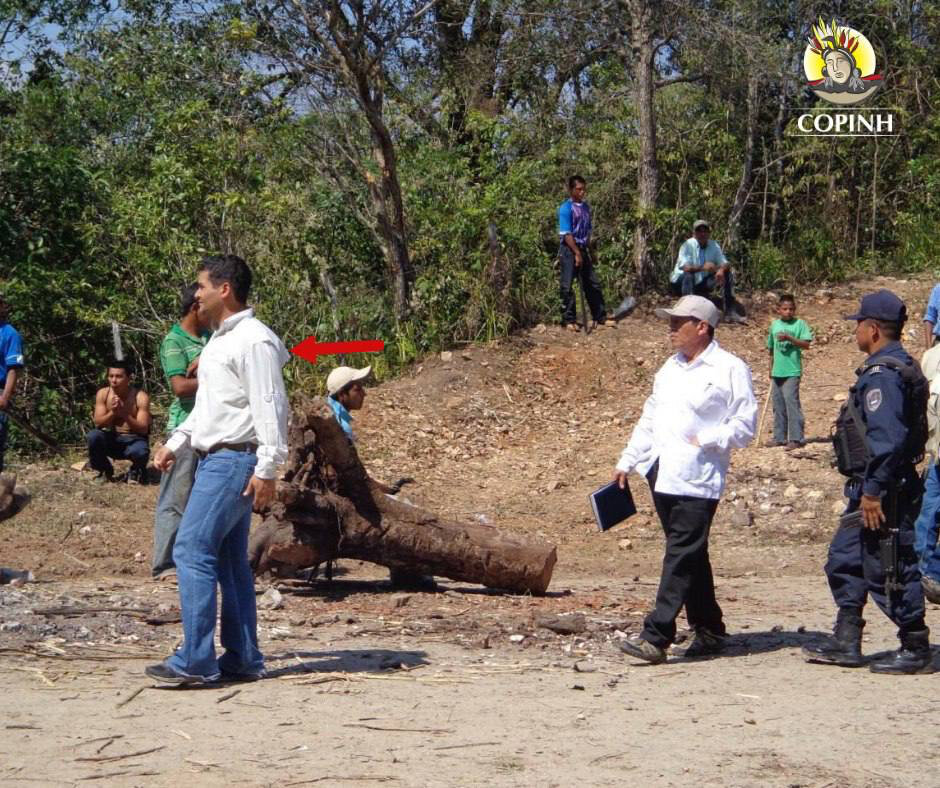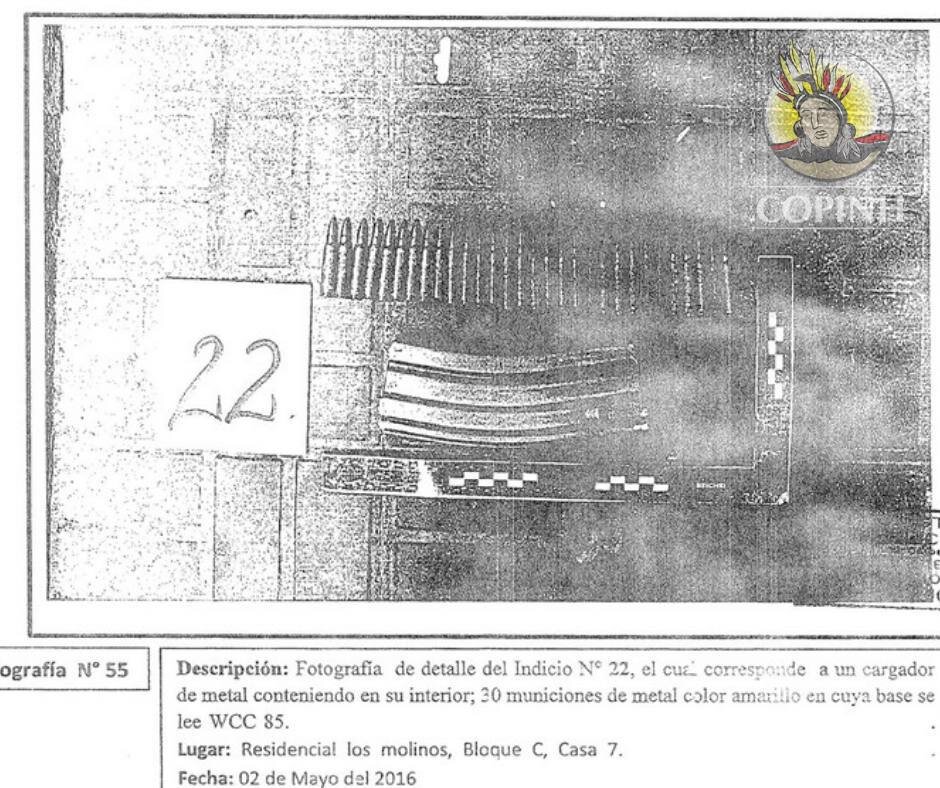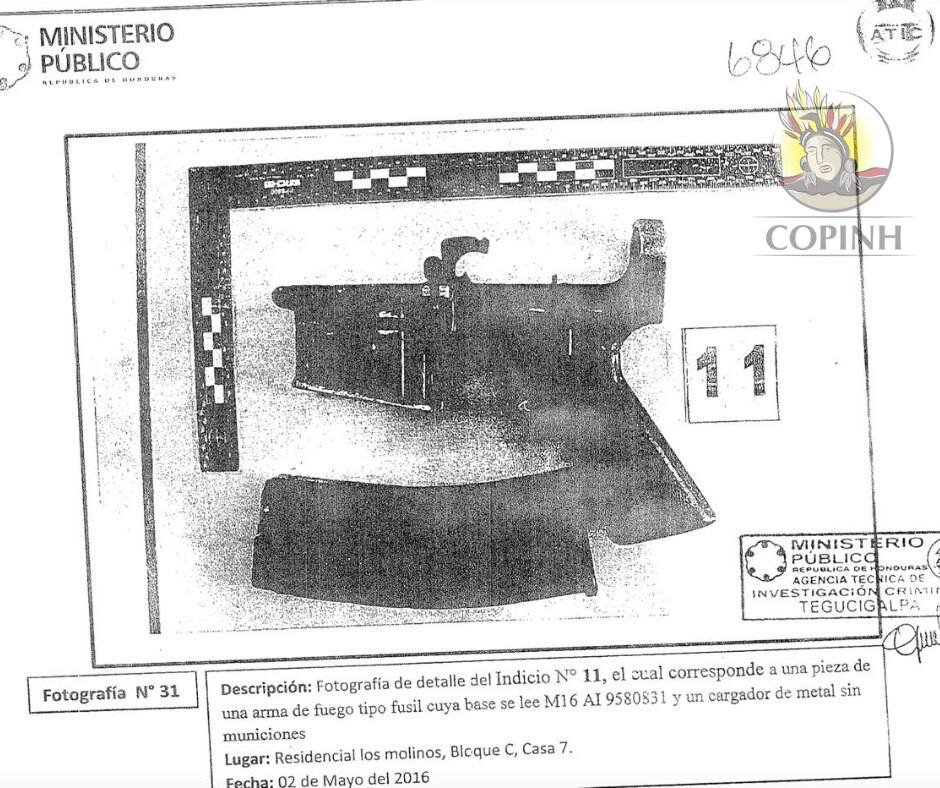DAY SIX: Trial Against David Castillo
/Last update: April 30 at 2:09 pm. There are still evidentiary documents that still need to be presented on Friday, April 30. This was incorrectly reported on April 29 and has been fixed below.
Main Points of the Day
Rosalina Dominguez, a Lenca leader from the community of Rio Blanco testified. Dominguez declared that David Castillo had visited Rio Blanco on a few occasions insisting that the Agua Zarca project be built (see photos below). Dominguez described the role that Berta Cáceres and COPINH played in assisting the community defend their territory and the violence that was caused by DESA including the destruction of crops, murder, threats, etc. Dominguez spoke about Berta mentioning Castillo, telling Dominguez that Castillo would send her weird messages inviting her to go to swim in the river, and that if anything ever happened to her, it would be Castillo’s fault.
One investigative document describing the raid on Douglas Bustillo’s home included the discovery of parts of an M16 weapon. During the course of the day, COPINH publicly denounced that the weapon belonged to the Honduran Armed Forces and under Honduran law, it is illegal for unauthorized individuals to possess such military-grade weapons (see photos below).
In one investigative document, an agent spoke about finding uniforms with the logos and names of the ‘Anti-Narcotics Directorate’ (DLCN) and ‘Attorney General’ in DESA’s office when it was raided.
Several documents were ratified by individuals involved in the investigations, raids, and seizures of property related to the murder case.
The live transmission continued to cut out regularly throughout the day making it extremely difficult to follow the proceedings. Some parts were missed entirely. Trial was suspended at 9:20 pm.
Tomorrow, prosecutors will continue to present their evidence (only expert testimony/analyses and witness testimonies remain). It is possible that the prosecutor’s key expert telecommunications witness, Brenda Barahona, will testify. Proceedings are scheduled to begin at 1:30 pm.




For picture one and two, COPINH writes: “Just as Rosalina mentioned, these images are evidence of David Castillo’s presence in the El Roble blockade carried out by the Rio Blanco community. Despite the community telling Castillo that they would not permit the construction of the hydroelectric project due to the violation of the right to free, prior, and informed consent, he continued to impose his boss’s - the Atala Zablah family - project through violence and death.”
For picture three and four, COPINH writes: “According to executing judge Luis Ramírez’s testimony, in Douglas Bustillo’s home, they found parts of an M16 weapon and a magazine. This is a weapon is for the exclusive use of security forces. According to Article 332 of the Criminal code, “an unauthorized person that … stores military-grade or combat materials … will be punished with 8 to 10 years in prison.” Nevertheless, this crime remains in impunity because the Attorney General’s office has not acted. The same Attorney General’s office that in 2013, imprisoned Berta Cáceres for a similar accusation that was ordered by DESA which was directed by David Castillo and is property of the Atala Zablah family. It is the duty of the Attorney General’s office to proceed against Douglas Bustillo for this crime.”
More Details
Testimony of Rosalina Dominguez
NOTE: These notes simple paraphrase the testimony and include the questions and answers that are most relevant to the specific accusations against David Castillo.
Declaration: The community carried out a territorial exercise in Rio Blanco. The company violated our right to free, prior and informed consent and Convention ILO 169. In the community, we decided to stop the machines from circulating, and David Castillo, because we were not consulted. The company just caused environmental destruction.
Prosecutor’s questions:
Why did you say you have a personal interest in testifying? A: I have an interest because I want justice for Berta Cáceres and the Rio Blanco community. Our community has not been respected as an indigenous community.
Q: Why is ILO 169 important? A: Convention 169 says that indigenous communities must be consulted and no one can come and invade our territories without our consent.
Q. Why did the community defend the river? A: It’s a sacred river that we use to swim, and its life, for animals and us.
Q: What does the river spiritually represent? A: Spiritually, the river is the force of life and it gives us life … everything around the river.
Q: On these territorial exercises, where did you go? A: We went to the side of the river where DESA was building the dam and we continued to insist to David Castillo, that Rio Blanco didn’t want the project.
Q: In what way did you inform David Castillo that the community was not in agreement with the project? A: We told him that we didn’t want the machinery. And he came into the community and said that the project was going to be built.
Q: How do you know he said this? A: Because he said it in front of the whole community of Rio Blanco.
Q: How many times did Berta Cáceres visit El Roble [the place where the communities maintained a blockade preventing DESA from accessing the river]. A: Berta was more from Rio Blanco than she was from La Esperanza, because she was with us more there than in La Esperanza. She never left us alone and always accompanied us. COPINH was always with us.
Q: When was the last time Berta Cáceres visited Rio Blanco? A: The last time was when we did the territorial exercise in San Francisco de Ojuera on February 20 [2016]. DESA used their machines to block the road so that we couldn’t pass to the river. There were about 300 of us participating in the territorial exercise.
Q: How do you know the machines belonged to DESA? A: Sergio Rodriguez told Berta, “don’t sacrifice your people, don’t take your people there.” And Berta asked us what we wanted to do. We told her that we wanted to get to the river. We got there at 6 pm.
Q: What was Sergio Rodriguez’s attitude? A: He asked us why we continued with Berta if she was making us stand in the sun? He told us to go look for work. Berta told us it was our decision to be there.
Q: At 6 pm, what did you do when you got to the river? A: We insisted that they send us our buses and that if they didn’t, we would stay there that night at the side of the Gualcarque river. We couldn’t go walking and it was the evening. We left the river at 10 pm. From there, people threw rocks at the car Berta was traveling in and they called her an “old witch” [vieja bruja]
Q: How do you know that happened to Berta? A: Because I was in the same car with her.
Private accuser #1’s questions:
Q: You said that ‘they’ killed Tomas García, who is they? A: I said they because Sinohydro and DESA were there. In that instance, Sinohydro left after Tomas was killed, and DESA stayed.
Why did those people in the community attack Berta? A: Because she supported the community.
What did Berta Cáceres’ murder mean to you? A: For us, taking Berta .. it was an emptiness that they left us because she left behind a legacy. She was a good person, she respected the communities, she valued our rights. So it was painful and when we heard they had killed her, the entire community went to “plant” her [bury her].
Private accuser #2’s questions:
Q: What was your relationship with Berta Cáceres? A: I was always with her. When they criminalized her, I was with her in La Esperanza.
Q: In what occasions did you see David Castillo? A: I saw him three times.
Q: What was Castillo’s attitude when you saw him at El Roble? A: His attitude was that the community had to allow the project. He asked Berta to tell us to accept the project and Berta asked us, and the community said no, that the machines had to stop and weren’t allowed in the community.
Q: To finish, what was Berta’s relationship with Castillo? A: Her relationship with him didn’t exist. What she said was that Castillo was sending her weird messages to her phone. He would invite her to swim in the Gualcarque river in the deepest area.
Q: And what did Berta say about these messages? A: She said that he invites her to swim and that if anything happens to her or to Tomas, that it’s David Castillo’s fault.
Defense’s questions:
Q: You said you were injured in a car accident in Rio Blanco, how was your recovery? A: I almost died in the hospital because there was no medical attention. So I went home to recover.
Q: Who helped you recover? A: Luis Green [government representative]. One compañera told me that David Castillo said he had put 18,000 Lps in my hands. I never received this.
Case Documents Ratified and Discussed
Intelligence agent Jefferson Roberto Valladares Matamoros ratified photos and investigative document dated March 6, 2016 of the inspection of the damages to Berta Cáceres’ home during the murder.
[Transmission cut out, person not identified]. Ratified the document outlining the raid at DESA’s office on May 2, 2016.
Maria Paola Quintero ratified a document and the physical cell phone confiscated from Sergio Rodriguez during his arrest. [There was an error between the copy presented to the court and the original. The court will investigate and return to this document once the original is examined].
Investigator Leticia Naja ratified the document of the raid on a house in La Ceiba. [The house belonged to one of the individual convicted for Berta’s murder].
Investigative agent Luis Enrique Ramirez ratified the document of the raid on Douglas Bustillo’s house on May 2, 2016. It was established in the questioning that parts of an M16 weapon was found in the house.
Investigative agent from ATIC, Yosly Carías Cruz ratified the document and photos of the raid on Douglas Bustillo’s house.
David Joel Alvarez Zelaya ratified a technical document including photos of the raid of DESA’s office carried out on May 2, 2016. During this raid, uniforms belonging to the Attorney General’s office and the Anti-Narcotics Directorate (DLCN).
[There were approximately two other documents that were ratified and discussed when the live transmission cut out].
